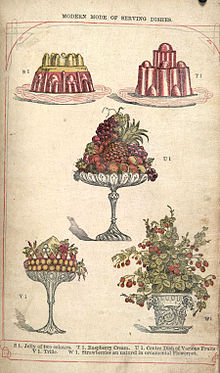Trifle
 | |
| Course | Dessert |
|---|---|
| Place of origin | Britain |
| Main ingredients | Variable: Sponge biscuit (ladyfinger), Sherry, custard, fruit, whipped cream |
Trifle is a layered dessert found in British and other cuisines. Made with a thin layer of sponge fingers commonly soaked in sherry or another fortified wine, custard and a fruit element (fresh, or jelly), the contents of a trifle are highly variable; many varieties exist, some forgoing fruit entirely and instead using other ingredients, such as chocolate, coffee or vanilla. The fruit and sponge layers may be suspended in fruit-flavoured jelly, and these ingredients are usually arranged to produce three or four layers. The assembled dessert can be topped with whipped cream, or, more traditionally, syllabub.
The name trifle was used for a dessert like a fruit fool in the sixteenth century; by the eighteenth century, Hannah Glasse records a recognisably modern trifle, with the inclusion of a gelatin jelly.
History[]

The earliest use of the name trifle was in a recipe for a thick cream flavoured with sugar, ginger and rosewater, in Thomas Dawson's 1585 book of English cookery The Good Huswifes Jewell.[1] Trifle evolved from a similar dessert known as a fool, and originally the two names were used interchangeably.[2]
Jelly is first recorded as part of the recipe in later editions of Hannah Glasse's eighteenth century book The Art of Cookery. In her recipe she instructed using hartshorn or bones of calves' feet as the base ingredient (to supply gelatin) for the jelly.[3] The poet Oliver Wendell Holmes wrote of trifles containing jelly in 1861.[4]
Variations[]
Trifles may contain a small amount of alcohol such as port or punsch, raisin wine, or curacao.[5]
The Scots have a similar dish to trifle, tipsy laird, made with Drambuie or whisky.[6]

Similar desserts[]
In Italy, a dessert similar to and probably based on trifle is known as zuppa inglese, literally "English soup".[7]
See also[]
- Cassata – Type of sponge cake
- Crema de fruta – Filipino layer cake
- Pavê – Brazilian layered cake - Brazilian dessert
- Icebox cake - American dessert
- List of custard desserts
- Parfait – Frozen dessert
- Pudding – Type of food
References[]
- ^ The Good Husvvifes Ievvell. WorldCat. OCLC 606520795.
- ^ "Three British Desserts: Syllabub, Fool and Trifle". Article by Diana Serbe. Archived from the original on 13 May 2010. Retrieved 19 July 2010.
- ^ Hannah Glasse (1774). The Art of Cookery. Internet Archive. p. 285. Retrieved 25 February 2014.
- ^ "Practically Edible article on Trifle". Practically Edible; The Web's Biggest Food Encyclopedia. Archived from the original on 2 February 2011. Retrieved 19 July 2010.
- ^ "Marmalade trifle". British Food in America.
- ^ Maw Broon (2007). Maw Broon's Cookbook. Waverley Books; (18 October 2007) ISBN 1-902407-45-8, p. 111
- ^ "Zuppa inglese". Larousse Gastronomique. New York: Clarkson Potter. 2001. p. 1310.
- Australian desserts
- British cuisine
- British desserts
- Christmas food
- Custard desserts
- Foods with alcoholic drinks
- New Zealand desserts
- Sponge cakes